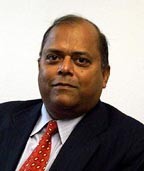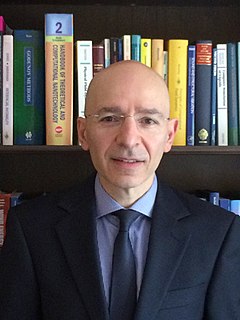
Aerodynamics, from Greek ἀήρ aero (air) + δυναμική (dynamics), is the study of motion of air, particularly when affected by a solid object, such as an airplane wing. It is a sub-field of fluid dynamics and gas dynamics, and many aspects of aerodynamics theory are common to these fields. The term aerodynamics is often used synonymously with gas dynamics, the difference being that "gas dynamics" applies to the study of the motion of all gases, and is not limited to air. The formal study of aerodynamics began in the modern sense in the eighteenth century, although observations of fundamental concepts such as aerodynamic drag were recorded much earlier. Most of the early efforts in aerodynamics were directed toward achieving heavier-than-air flight, which was first demonstrated by Otto Lilienthal in 1891. Since then, the use of aerodynamics through mathematical analysis, empirical approximations, wind tunnel experimentation, and computer simulations has formed a rational basis for the development of heavier-than-air flight and a number of other technologies. Recent work in aerodynamics has focused on issues related to compressible flow, turbulence, and boundary layers and has become increasingly computational in nature.

Mach number is a dimensionless quantity in fluid dynamics representing the ratio of flow velocity past a boundary to the local speed of sound.
Compressible flow is the branch of fluid mechanics that deals with flows having significant changes in fluid density. While all flows are compressible, flows are usually treated as being incompressible when the Mach number is smaller than 0.3. The study of compressible flow is relevant to high-speed aircraft, jet engines, rocket motors, high-speed entry into a planetary atmosphere, gas pipelines, commercial applications such as abrasive blasting, and many other fields.

Computational fluid dynamics (CFD) is a branch of fluid mechanics that uses numerical analysis and data structures to analyze and solve problems that involve fluid flows. Computers are used to perform the calculations required to simulate the free-stream flow of the fluid, and the interaction of the fluid with surfaces defined by boundary conditions. With high-speed supercomputers, better solutions can be achieved, and are often required to solve the largest and most complex problems. Ongoing research yields software that improves the accuracy and speed of complex simulation scenarios such as transonic or turbulent flows. Initial validation of such software is typically performed using experimental apparatus such as wind tunnels. In addition, previously performed analytical or empirical analysis of a particular problem can be used for comparison. A final validation is often performed using full-scale testing, such as flight tests.
AUSM stands for Advection Upstream Splitting Method. It is developed as a numerical inviscid flux function for solving a general system of conservation equations. It is based on the upwind concept and was motivated to provide an alternative approach to other upwind methods, such as the Godunov method, flux difference splitting methods by Roe, and Solomon and Osher, flux vector splitting methods by Van Leer, and Steger and Warming. The AUSM first recognizes that the inviscid flux consist of two physically distinct parts, i.e., convective and pressure fluxes. The former is associated with the flow (advection) speed, while the latter with the acoustic speed; or respectively classified as the linear and nonlinear fields. Currently, the convective and pressure fluxes are formulated using the eigenvalues of the flux Jacobian matrices. The method was originally proposed by Liou and Steffen for the typical compressible aerodynamic flows, and later substantially improved in to yield a more accurate and robust version. To extend its capabilities, it has been further developed in for all speed-regimes and multiphase flow. Its variants have also been proposed.

Sergei Konstantinovich Godunov is professor at the Sobolev Institute of Mathematics of the Russian Academy of Sciences in Novosibirsk, Russia.
Flux limiters are used in high resolution schemes – numerical schemes used to solve problems in science and engineering, particularly fluid dynamics, described by partial differential equations (PDE's). They are used in high resolution schemes, such as the MUSCL scheme, to avoid the spurious oscillations (wiggles) that would otherwise occur with high order spatial discretization schemes due to shocks, discontinuities or sharp changes in the solution domain. Use of flux limiters, together with an appropriate high resolution scheme, make the solutions total variation diminishing (TVD).

High-resolution schemes are used in the numerical solution of partial differential equations where high accuracy is required in the presence of shocks or discontinuities. They have the following properties:

Bram van Leer is Arthur B. Modine Emeritus Professor of aerospace engineering at the University of Michigan, in Ann Arbor. He specializes in Computational fluid dynamics (CFD), fluid dynamics, and numerical analysis. His most influential work lies in CFD, a field he helped modernize from 1970 onwards. An appraisal of his early work has been given by C. Hirsch (1979)

Guy Antony Jameson, FRS, FREng is Professor of Engineering in the Department of Aeronautics & Astronautics at Stanford University. Jameson is known for his pioneering work in the field of computational fluid dynamics. He has published more than 300 scientific papers in a wide range of areas including computational fluid dynamics, aerodynamics, and control theory.

A Riemann solver is a numerical method used to solve a Riemann problem. They are heavily used in computational fluid dynamics and computational magnetohydrodynamics.

John D. Anderson Jr. is the Curator of Aerodynamics at the National Air and Space Museum at the Smithsonian Institution in Washington, DC and Professor Emeritus in the Department of Aerospace Engineering at the University of Maryland, College Park.
In computational fluid dynamics, shock-capturing methods are a class of techniques for computing inviscid flows with shock waves. The computation of flow containing shock waves is an extremely difficult task because such flows result in sharp, discontinuous changes in flow variables such as pressure, temperature, density, and velocity across the shock.
The Roe approximate Riemann solver, devised by Phil Roe, is an approximate Riemann solver based on the Godunov scheme and involves finding an estimate for the intercell numerical flux or Godunov flux at the interface between two computational cells and , on some discretised space-time computational domain.
Wei ShyyJP is serving as the 4th President of the Hong Kong University of Science and Technology (HKUST) since 1 September 2018 with his acting presidency starting from 1 February 2018. He also holds concurrent appointment as Chair Professor of Mechanical & Aerospace Engineering. He first joined HKUST in August 2010 as Provost. Prior to this, he was Clarence L. “Kelly” Johnson Collegiate Professor and Chairman of the Department of Aerospace Engineering of the University of Michigan. He was previously employed by the University of Florida and GE Research and Development Center in Schenectady, New York. On 1 September 2018, he officially succeeded Tony F. Chan as President of HKUST.
Vorticity confinement (VC), a physics-based computational fluid dynamics model analogous to shock capturing methods, was invented by Dr. John Steinhoff, professor at the University of Tennessee Space Institute, in the late 1980s to solve vortex dominated flows. It was first formulated to capture concentrated vortices shed from the wings, and later became popular in a wide range of research areas. During the 1990s and 2000s, it became widely used in the field of engineering.

Ramesh K. Agarwal is the William Palm Professor of Engineering in the department of Mechanical Engineering and Materials Science at Washington University in St. Louis. He is also the director of Aerospace Engineering Program, Aerospace Research and Education Center and Computational Fluid Dynamics Laboratory at WUSTL. From 1994 to 1996, he was the Sam Bloomfield Distinguished Professor and Chair of Aerospace Engineering department at Wichita State University in Wichita, Kansas. From 1996 to 2001, he was the Bloomfield Distinguished Professor and the executive director of the National Institute for Aviation Research at Wichita State University. Agarwal received Ph.D in Aeronautical Sciences from Stanford University in 1975, M.S. in Aeronautical Engineering from the University of Minnesota in 1969 and B.S. in Mechanical Engineering from Indian Institute of Technology, Kharagpur, India in 1968.

Dimitris Drikakis, PhD, FRAeS, CEng, is a Greek-British applied scientist, engineer and university professor. His research is multidisciplinary. It covers fluid dynamics, computational fluid dynamics, acoustics, heat transfer, computational science from molecular to macro scale, materials, machine learning, and emerging technologies. He has applied his research to diverse fields such as Aerospace & Defence, Biomedical, and Energy and Environment Sectors. He received The William Penney Fellowship Award by the Atomic Weapons Establishment to recognise his contributions to compressible fluid dynamics. He was also the winner of NEF's Innovator of the Year Award by the UK's Institute of Innovation and Knowledge Exchange for a new generation carbon capture nanotechnology that uses carbon nanotubes for filtering out carbon dioxide and other gases.
The finite point method (FPM) is a meshfree method for solving partial differential equations (PDEs) on scattered distributions of points. The FPM was proposed in the mid-nineties in, and with the purpose to facilitate the solution of problems involving complex geometries, free surfaces, moving boundaries and adaptive refinement. Since then, the FPM has evolved considerably, showing satisfactory accuracy and capabilities to deal with different fluid and solid mechanics problems.

Joseph Majdalani is an American professor of Mechanical and Aerospace Engineering. He began his career at Marquette University, before serving as both the Jack D. Whitfield Professor of High Speed Flows and Arnold Chair of Excellence at the University of Tennessee Space Institute. He then served as the Auburn Alumni Engineering Council Endowed Professor and Chair, and is currently the Hugh and Loeda Francis Chair of Excellence in Aerospace Engineering at Auburn University.











